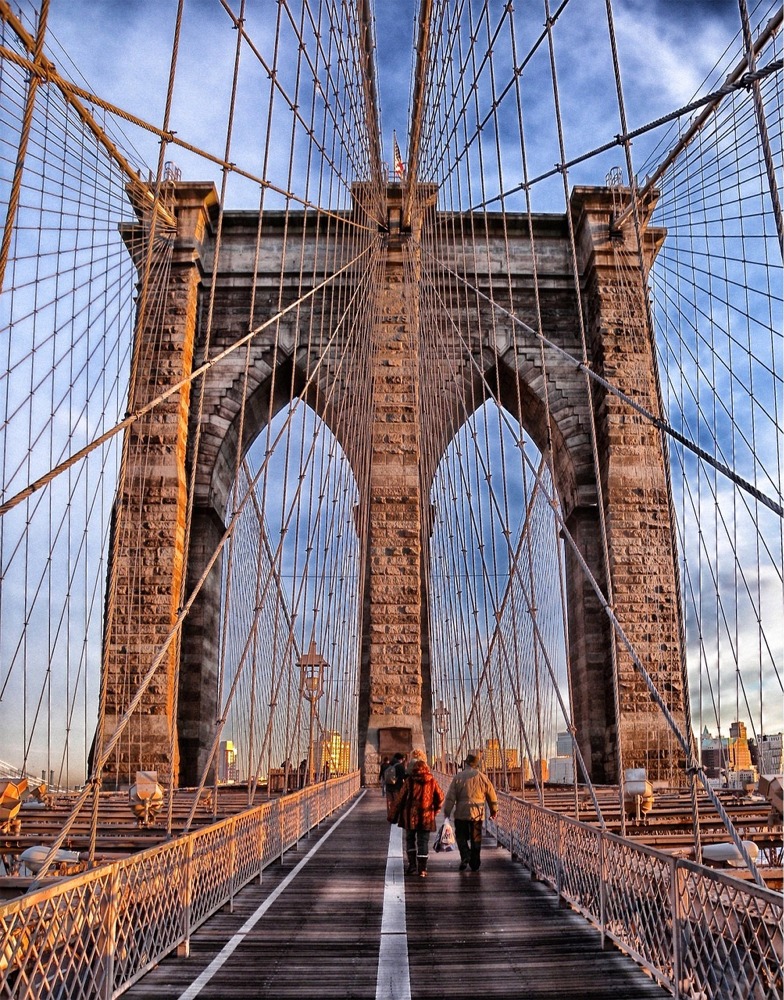Brooklyn Bridge Pier
Home > New York State Photographs > New York > Brooklyn Bridge Pier

The pedestrians shuffled off the ferry and made their way to the West pier of the Brooklyn Bridge. The sky was a mottled mix of white and blue, the setting sun illuminating the area in a warm, golden glow. The pier itself was an ancient structure, its stones weathered by years of wind and water, its suspension cables crisscrossing in an intricate latticework above.
The pedestrians, bundled in thick winter jackets, were heading home, their shopping bags clinking with the promise of warmth and the evening meal. As they reached the foot of the pier, their steps slowed, the tiredness of the day suddenly apparent in the way they stumbled and weaved. But then, as they saw the bridge, their steps quickened, the sight of the bridge's towers and arches seeming to rejuvenate them as they ascended towards the entrance.
The evening had been kind to them; even the clouds had parted and allowed the sun to light up the entire scene. The shadows of the bridge danced merrily, the stones becoming a thing of beauty as their ancient patina glistened in the sun's rays. To the pedestrians, it was a sight that could only be described as otherworldly, a sight that they never wanted to forget, a reminder of why they were so proud to call Brooklyn their home.
Brooklyn Bridge
The Brooklyn Bridge is an iconic landmark that spans the River, connecting the boroughs of Manhattan and Brooklyn in New York City. It is one of the oldest suspension bridges in the United States and has become a symbol of the city's engineering prowess and architectural beauty. Here's some information about the Brooklyn Bridge:
Construction
The construction of the Brooklyn Bridge began in 1869 and was completed in 1883. It was designed by the architect John A. Roebling, with assistance from his son Washington Roebling and his son's wife Emily Warren Roebling. The bridge's construction faced various challenges, including the use of caissons (large watertight chambers) for the bridge's foundations and the implementation of steel cable suspension technology.
Architecture and Design
The Brooklyn Bridge showcases a combination of Gothic and neo-Gothic architectural styles. It features two towers made of granite, limestone, and cement, connected by steel cables and suspension cables. The bridge has a total length of approximately 6,016 feet (1,834 meters) and a main span of 1,595.5 feet (486.3 meters), making it an impressive engineering feat of its time.
Function and Transportation
The Brooklyn Bridge serves as a vital transportation link between Manhattan and Brooklyn. It carries vehicular traffic, pedestrians, and cyclists. The bridge has two designated roadways for vehicles running in either direction, as well as an elevated walkway for pedestrians. It offers stunning views of the Manhattan skyline, the River, and the surrounding areas.
Landmark and Symbolism
The Brooklyn Bridge is recognized as a National Historic Landmark and has immense cultural significance. It represents the ingenuity and progress of New York City and has been featured in numerous films, literature, and artworks. The bridge is often associated with the American Dream and serves as a symbol of unity and connectivity.
Pedestrian Experience
Walking across the Brooklyn Bridge is a popular activity for both locals and tourists. The elevated walkway provides pedestrians with a scenic pathway to enjoy panoramic views of the city. Along the way, there are historical plaques and benches where visitors can rest and take in the surroundings.
Cultural and Social Importance
The Brooklyn Bridge has played a significant role in shaping the cultural fabric of New York City. It has inspired artists, writers, and photographers who have captured its grandeur and significance. The bridge has also been a site for public gatherings, celebrations, and demonstrations, reflecting its role as a symbol of civic pride and resilience.
The Brooklyn Bridge stands as an iconic landmark, a testament to human engineering and a cherished part of New York City's history. It continues to captivate and inspire people from around the world, attracting millions of visitors who come to admire its beauty and experience its unique charm.


